Lamasary
This Buddhist Tibetan temple in Beijing is the site where the Dalai Lama once
met with the Chinese premiere. Many worshippers and tourists visit this temple
throughout the year.
Even in the hot summer rain, worshippers light stalks of incense in preparation
to enter the Grand Tibetan Buddhist Yonghe Lamasery where the Dalai Lama
once met with the premiere of China.
|
 |
| |
Praying at Fire in Beijing |
Summer Palace
The Summer Palace, located in the outskirts of Beijing, was built as an Imperial
park in 1600-1900s. After it burnt down in 1860, it was renovated in 1888 by
Empress Dowager Cixi. It has become one of the symbols of civilization of mankind
in the world. The Summer Palace is on the UNESCO World Heritage list.
|
Lion statuary, usually placed at an entrance, is the
traditional symbol to ward off evil spirits. This one is at the Summer
Palace. |
Lion; Beijing |
|
 |
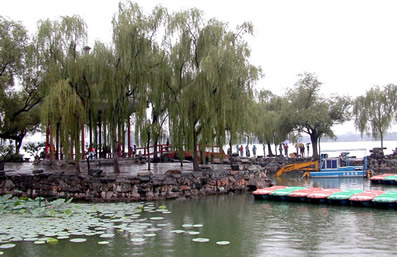 |
Lotus Blossoms, a staple in the Chinese diet, grow
in abundance at the Summer Palace. |
Island on Kunming Lake at the Summer Palace. |
 |
|
Visitor tour boats are quite popular with locals as
well as tourists on the Kunming Lake at the Summer Palace. |
|
| |
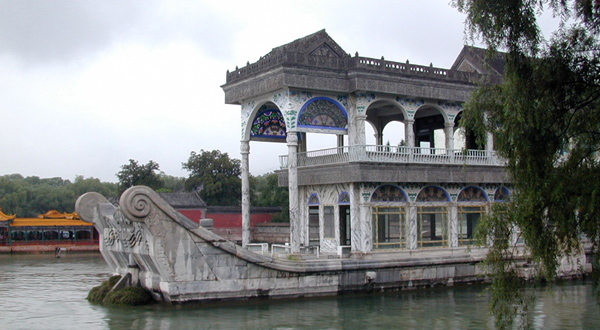 |
| |
36 meter long Marble Boat at the Summer Palace, built
at the behest of Empress Dowager Cixi around 1888. For obvious reasons,
it has never sailed. |
| |
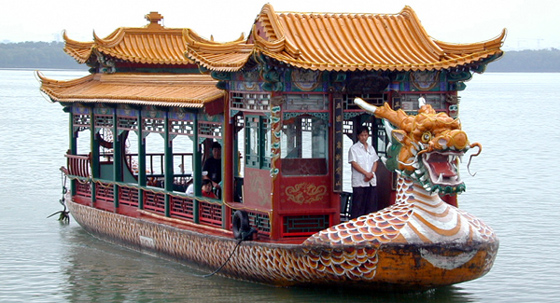 |
| |
Tour boat on Kunming Lake at the Summer Palace |
|
|
Tour boats on Kunming Lake at the Summer Palace are
always jam-packed with tourists as well as locals, especially on weekends,
even in downpours. |
|
Hutongs
For 600 hundred years, the hutongs, or close-knit neighborhoods, with their
narrow, winding streets, have been home to four million people. Many different
religious and social groups have lived here harmoniously without strife for
hundreds of years. The hutongs include kindergartens and child care facilities,
common sanitary and garbage facilities and a common caring concern for every
neighbor, young and old.
|
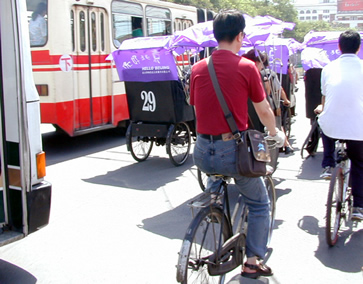 |
Bicyclists in Beijing's hutongs zip through the narrow
streets alongside the numerous pedicabs carrying tourists and residents
alike |
Pedicabs pick up tourists amid the crush of bicyclists
outside the Hutong. |
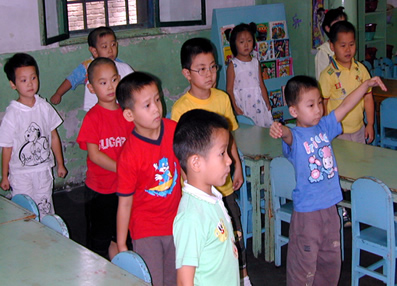 |
 |
Children at a Hutong Kindergarten. Notice the ratio
of boys to girls...9 to 1. This country-wide ratio promises to prove troublesome
once young men begin looking for wives. |
Children at a hutong Kindergarten. |
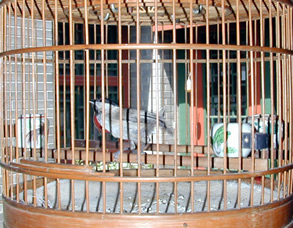 |
|
|
Many Chinese keep birds as pets. It's a symbol of
good luck |
|
|
Temple of Heaven
Built in 1420, this was the place for emperors to offer sacrifices to heaven.
It includes the Hall of Prayer for Good Harvest, Imperial Vault of Heaven and
Circular Mound Altar. It's one of China's outstanding ancient architectural
creations.
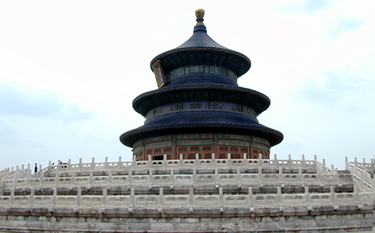 |
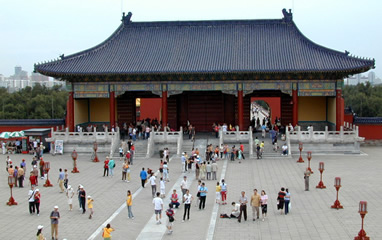
|
The Imperial Vault of Heaven at the Temple of Heaven,
one of China's outstanding ancient architectural creations. The Hall of
Prayer for Good Harvests and the Circular Mound Altar was the place for
emperors to offer sacrifices to heaven. |
Courtyard at the Temple of Heaven, teeming with visitors, both local
and foreign.
|
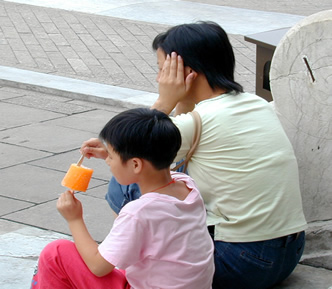 |
|
Mother and son pause in their visit to the Temple
of Heaven to beat the heat with an ice cream and a rest |
|
|
|
Mother and son pause in their visit to the Temple
of Heaven to beat the heat with an ice cream and a rest. |
Young girl with festive headdress. These adornments
are available at many tourist stores throughout the country. |
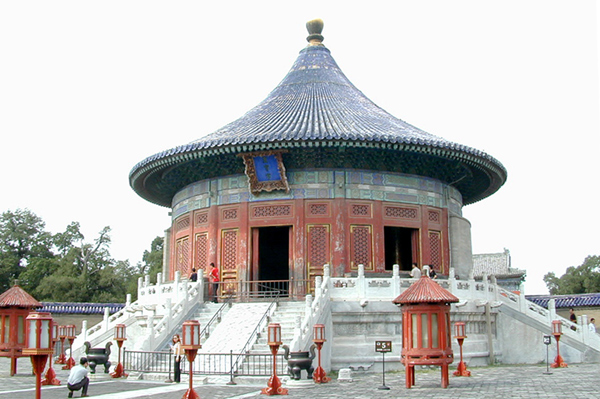 |
|
Vault in the Temple of Heaven where the memorial tablets
to heaven were placed. |
|
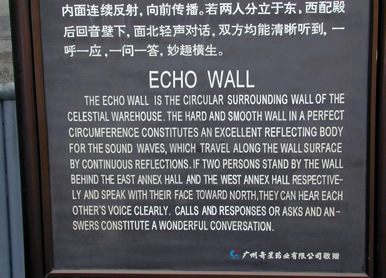 |
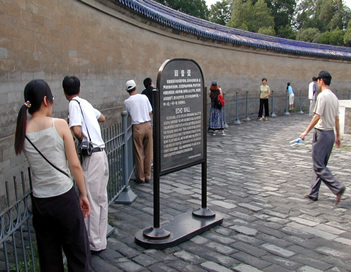 |
Signage at the Echo Wall at the Imperial Vault's Celestial
Warehouse at the Temple of Heaven |
The Echo Wall at the Imperial Vault's Celestial Warehouse
at the Temple of Heaven. |
|
|
Visitors flock to the courtyard outside the Imperial
Vault at the Temple of Heaven, even on weekdays. |
|
Peking Opera
The traditional Peking Opera has many troupes which perform at venues all over
the Chinese countryside. This venue, at what was once Prince Gong's private
gardens, is now open for special events and performances. The Opera performers
are expert in the following disciplines: fighting, singing, dancing, acrobatics,
juggling, acting, pantomime and gesturing. In order to become a troupe member,
an artist must have all these skills.
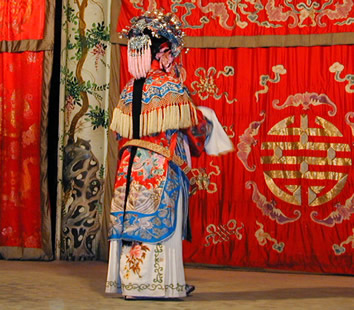 |
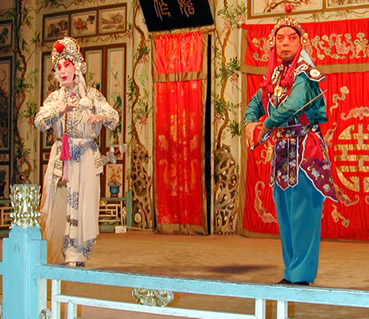 |
Many different troops of the Peking Opera perform at
many venues throughout China. This performance was at Prince Gong's private
garden theater in Beijing. |
Traditionally, ornately costumed Peking Opera singers
perform at Prince Gong's private garden theater in Beijing. |
| |
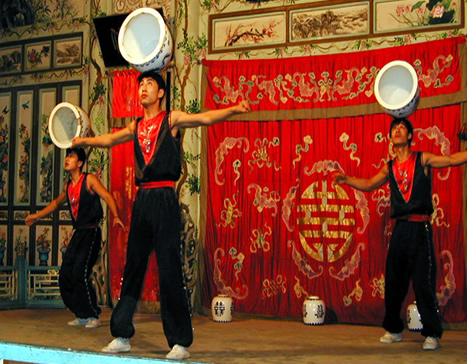 |
| |
Jugglers are an integral part of the traditional Peking
Opera. These three performers juggle heavy porcelain vases. |
The Great Wall
Originally built as a gigantic defensive devise in the 7th century BC against
invasion by nomadic tribes in the north, the Great Wall runs from the Gansu
Province in the west all the way to the sea in the east. Most of the Wall has
been renovated and is known today as one of the world's wonders. The Great Wall
is on the UNESCO World Heritage list. It can clearly be seen from outer space.
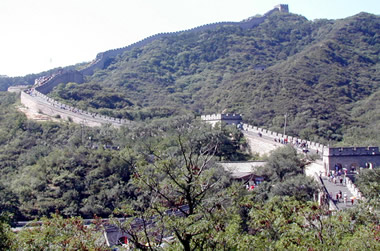 |
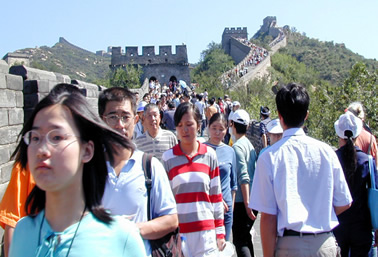 |
The Great Wall seen at Badaling, just outside Beijing,
stretches into infinity. |
The Great Wall is a popular tourist attraction for both
international tourists and those from inside China as well. On weekends,
the wall is wall-to-wall |
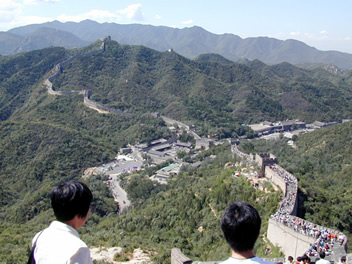 |
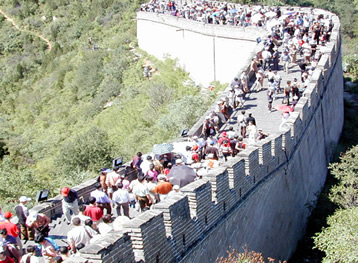 |
From one of the upper battle platforms on the Great
Wall, the spread of the base infrastructure of shops, restaurants, and
tourist parking lots is apparent on either side of the ancient structure. |
More wall-to-wall visitors on The Great Wall of China
at Badaling. |
Forbidden City/Palace Museum
The Palace Museum, also known as the Forbidden City, was built in the 1400s.
The largest and most complete group of palace buildings in China today, the
complex, with its magnificent construction and collection of arts and antiquities,
is now a museum of world importance for Chinese history, culture and art. It
is on UNESCO's World Heritage List.
 |
|
Two guards on a break play ping pong at the Forbidden
City. |
|
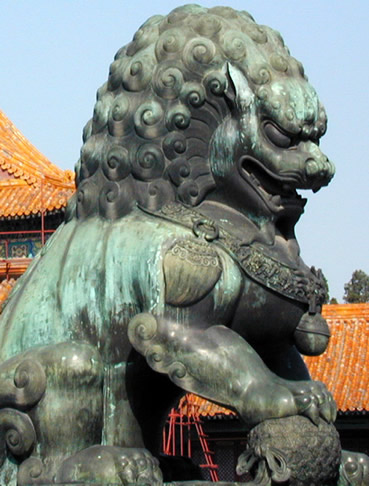 |
Beijing; Statuary at the Palace Museum in the Forbidden City
in Beijing, Bronze Lion at an entrance. The Lion guards the entrance to
a dwelling or temple, always in a pair, male and female. This, the male,
has a ball under his paw, symbolizing strength and power. On the other side
of the entrance, the female of the couple has her paw on her cub to symbolize
the care for children. They both ward off evil spirits. |
| |
|
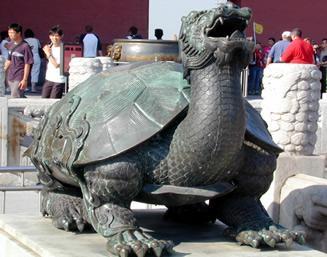 |
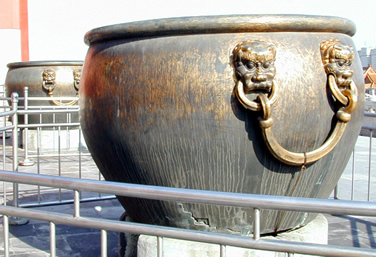 |
This bronze turtle in the courtyard of the Forbidden
City is a symbol of longevity. |
Bronze wine vats at the Palace Museum in the Forbidden
City in Beijing. These bronze vats are decorated with hornless unicorns. |
Exercise opportunities
In China you don't have to join a health club to get your daily exercise. There
are public exercise opportunities everywhere in the city. It's a cultural mandate!
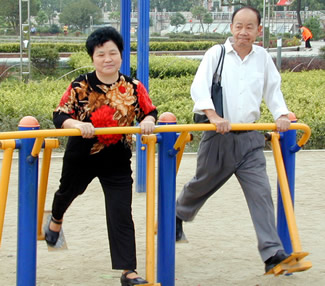 |
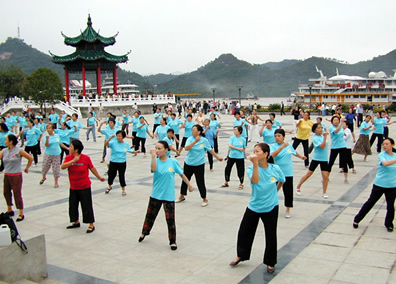 |
Couples jump on public walker exercise devices in public
parks which are available everywhere throughout the city. |
Mass public morning exercise |
|